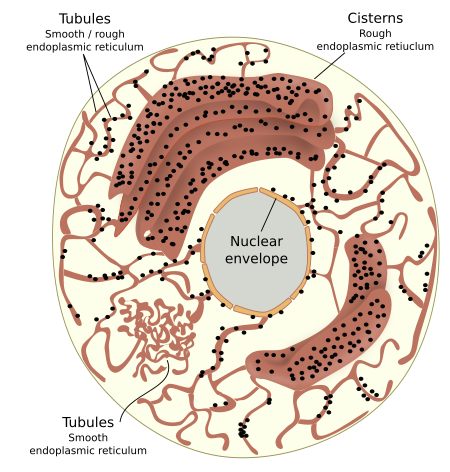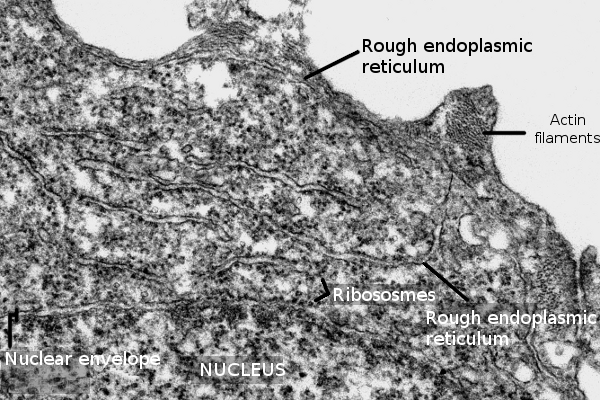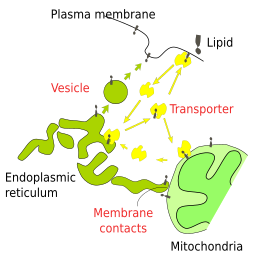The endoplasmic reticulum is a complex membrane-bound compartment arranged in tubules and flattened cisterns connected to one another and sharing the same lumen (inner space). Endoplasmic reticulum membranes are found through the cytoplasm, from the nuclear envelope to near the plasma membrane, so that they can account for half of the total cellular membranes. The nuclear envelope membranes are continuous with the endoplasmic reticulum membranes.
The endoplasmic reticulum membranes are organized in domains (Figure 1). The rough endoplasmic reticulum is characterized by having ribosomes associated with their cysotolic membrane surface, and it is organized in tubules and cisterns. The smooth endoplasmic reticulum is organized in irregular and convoluted tubules, with no associated ribosomes. The nuclear envelope is the third domain.

Rough and smooth endoplasmic reticulum do not usually share the same cytosolic space. This non-overlapping distribution is observed in hepatocytes, neurons and cells synthesizing steroid hormone. However, in some cytosolic regions there is no clear segregation between both domains, and tubules with associated ribosomes are intermingled with naked tubules.
The endoplasmic reticulum is the source of molecular components for other organelles, such as Golgi apparatus, lipid droplets and peroxisomes.
1. Rough endoplasmic reticulum
The rough endoplasmic reticulum is organized in more or less straight tubules and flattened cisterns. Sometimes, cisterns are tidily piled. The name "rough" comes from the electron microscopy images where ribosomes, black particles, are observed coating the endoplasmic reticulum membrane (Figures 1 and 2). The density of associated ribosomes influences the rough endoplasmic reticulum membrane organization, so that a high density causes a cistern-like morphology, whereas lower density is found in tubules. Cisterns and tubules coexist in the same cell, but those cells with an intense secretory activity show dense piles of cisterns, which means a highly developed rough endoplasmic reticulum.

Protein synthesis is the main function of the rough endoplasmic reticulum. These proteins end up at different places, such as the extracellular space, plasma membrane, or at membranes and lumen of several organelles involved in the vesicular trafficking. Furthermore, rough endoplasmic reticulum needs to synthesized proteins for itself, which are known as resident or constituent proteins.
Protein synthesis begins in cytosolic free ribosomes, but ends up in the endoplasmic reticulum, leaving the protein either free in the lumen or as part of the reticulum membrane. Those proteins that perform their functions in the lumen of cell organelles or outside the cell are released in the lumen of the endoplasmic reticulum, and those proteins that integral membrane proteins are inserted in the membrane of the endoplasmic reticulum during the synthesis process. Non-resident proteins, either soluble or integral membrane proteins, are enclosed in vesicles, leave the endoplasmic reticulum, and enter the vesicular trafficking.
2. Smooth endoplasmic reticulum
The smooth endoplasmic reticulum is a network of interconnected tubules that is continuous with the rough endoplasmic reticulum. There are no ribosomes associated with its membrane; therefore, it is named smooth. The smooth endoplasmic reticulum is abundant in those cells involved in lipid metabolism or detoxification, and it is also an organelle for calcium storage.
Salient functions of the smooth endoplasmic reticulum are:
Lipid synthesis
Most membrane lipids are assembled in the smooth endoplasmic reticulum membranes, including glycerophospholipids and cholesterol. Most of the sphingolipid synthesis, however, happens in the Golgi apparatus, but ceramide, the basic component of sphingolipids, is assembled in the smooth endoplasmic reticulum. Synthesized lipids are initially placed in the cytosolic hemilayer of the endoplasmic reticulum membrane. However, the two hemilagyers of the endoplasmic reticulum membrane show similar lipid composition. Lipids are transferred to the lumen hemilayer (that facing the lumen) by specialized proteins that can move lipids from one monolayer to the other: flippases, floppases and scramblases. Cholesterol is another main component of post-Golgi membranes, largely synthesized in the smooth endoplasmic reticulum. Lipids are shipped to other cell membranes by different transport pathways (Figure 3).

Mitochondria, chloroplasts and peroxisomes are not part of the vesicular traffic, so some membrane lipids are synthesized locally, but many others are imported from the endoplasmic reticulum by molecular carriers. Physical contacts between membranes of different organelles facilitate the exchange of lipids between these membranes.
Triacylglycerols are also synthesized in the smooth endoplasmic reticulum. These lipids are stored in the reticulum itself or as lipid droplets. The synthesis of triacylglycerols is intense in adipocytes. The overproduction of lipids is stored as cytoplasmic lipid droplets. Lipids synthesized in the smooth endoplasmic reticulum form the lipidic component of the lipoproteins, and are required for the production of steroid hormones and bile acids.
Detoxification
Hepatocytes, the liver cells, show a highly developed smooth endoplasmic reticulum. In the smooth endoplasmic reticulum membranes, there are enzymes responsible for removing potentially toxic metabolites, as well as liposoluble toxins assimilated during digestion.
Dephosphorylation of 6-phosphate glucose
Glucose is usually stored as glycogen, mainly in the liver. Catabolism of glycogen produces 6-phosphate glucose, which cannot cross the cell membrane and therefore cannot leave the cell. Glucose 6-phosphatase, which is anchored to the endoplasmic reticulum, removes the phosphate, and glucose can now be taken out of the cell.
Calcium storage
The smooth endoplasmic reticulum also works as a compartment for intracellular calcium storage. Stored calcium is released by extracellular and intracellular signals acting via second messengers, resulting in a cellular response, such as exocytosis and muscle cell contraction.
Bibliography
English AR, Zurek N, Voeltz GK. 2009. Peripheral ER structure and function. Current opinion in cell biology. 21:506-602.
Daleke DL. 2007. Phospholipid Flippases. The journal of biological chemistry. 282:821-825.
Nixon-Abell J, Obara, CJ, Weig VA, Li D, Legant WR, Xu CS, Pasolli HA, Harvey K, Hess HF , Betzig E, Blackstone C, Lippincott-Schwartz3 J. 2016. Increased spatiotemporal resolution reveals highly dynamic dense tubular matrices in the peripheral ER. Science. 354: 3928-2.
 Vesicular trafficking
Vesicular trafficking 